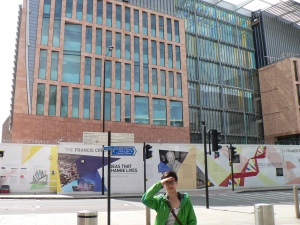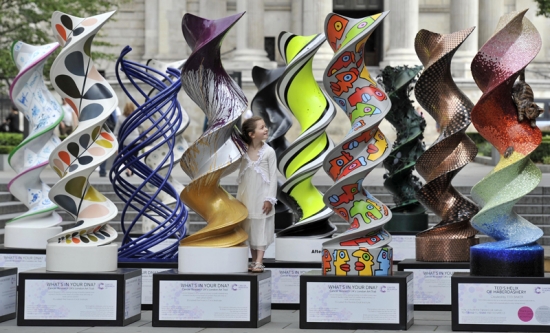Here I am standing in front of the gigantic Francis Crick Institute in London, which is situated right next to St. Pancras railway station and just behind the British Library. I’m not actually saluting, just shielding my eyes from the sun. [Photo courtesy: Kai Wang]
As you can see, even a wide-angle lens cannot quite capture all of the building in a single shot. A recent News article in Nature described the institute as “Sir Paul’s Cathedral”. It will be the biggest biomedical research centre in Europe – it’s bigger than Buckingham Palace – and will become populated with scientists early next year. The building costs came to a whopping £700 million. Additionally, its annual budget will be £150 million, which is more than the School of Biological Sciences at the University of Cambridge received in the academic year 2013/14 according to this report (if I am interpreting it correctly). The charity Cancer Research UK (CRUK) is one of the Crick’s main funders and this summer they are launching an art campaign to raise money for the Crick: CRUK is setting up 21 DNA sculptures across London so that you can go on a DNAtrail and at the end of the exhibit the “sculptures will be auctioned in September 2015 to raise funds to help complete the construction of the Francis Crick Institute”. Makes it sound slightly like they won’t be able to complete the building unless the auction goes really well… As far as I’m aware the Crick already has a roof and is currently being furnished. [Picture copied from the CRUK website.]
Sir Paul Nurse’s “Crick project” was/is daring and the numbers above are certainly impressive. But with this grandeur come great expectations. Sceptics of the project will be awaiting great results, results even better (and by that I probably mean more translatable into medicine and the real world) than those already being produced by the research groups moving into the Crick. Although I have no doubt that it will be an exciting place to work, with excellent facilities and support staff, I can imagine it will also be a high pressure environment. We shall see.
At the moment it’s barely been a week since I graduated with my undergraduate degree (woohoooo!) and part of my brain is already getting a little bit impatient for something new to think about and to work on. Another, perhaps more calculating, part of my brain is saying, “Are you mad? Enjoy these weeks of freedom. You’ll never have holidays like these again!” In any case, the PhD doesn’t start until September but in the mean time I’m scheduled to join a lab meeting of my future lab in late July. That means that I should do a bit of preparatory reading beforehand, including the lab’s most recent publications (see below).
References:
Behrens A, van Deursen JM, Rudolph KL, Schumacher B (2014) Impact of genomic damage and ageing on stem cell function. Nature Cell Biology 16: 201-207
Chakraborty A, Diefenbacher ME, Mylona A, Kassel O, Behrens A (2015) The E3 ubiquitin ligase Trim7 mediates c-Jun/AP-1 activation by Ras signalling. Nat Commun 6: 6782
Diefenbacher ME, Chakraborty A, Blake SM, Mitter R, Popov N, Eilers M, Behrens A (2015) Usp28 Counteracts Fbw7 in Intestinal Homeostasis and Cancer. Cancer Research 75: 1181-1186
Sancho R, Gruber R, Gu G, Behrens A (2014) Loss of Fbw7 reprograms adult pancreatic ductal cells into alpha, delta, and beta cells. Cell Stem Cell 15: 139-153
Sancho R, Cremona CA, Behrens A (2015) Stem cell and progenitor fate in the mammalian intestine: Notch and lateral inhibition in homeostasis and disease. EMBO Reports 16: 571-581
Schulein-Volk C, Wolf E, Zhu J, Xu W, Taranets L, Hellmann A, Janicke LA, Diefenbacher ME, Behrens A, Eilers M, Popov N (2014) Dual regulation of Fbw7 function and oncogenic transformation by Usp28. Cell Rep 9: 1099-1109



GOOD LUCK, those double helixes look distinctly different from the ones I saw in 1973…bioscience, University of Toronto, they get more colorful with the years…a good sign !!!
LikeLiked by 1 person
“even a wide-angle lens…” Maybe ultra-wide then? :)
LikeLike
Fisheye lens would certainly do it!
LikeLike
Exciting times! Do you know how many people and PhD’s will be flooding the site?
In terms of results, it’s a fairly wide held perception in the pharmaceutical industry that smaller R&D centers produce better results than monolithic ones. However I doubt this will be the case for the Crick as there won’t be an insane commercial pressure to produce a block buster drug and save the company. Also these centers tend to be in places that top talent would really prefer not to be. I’m sure the Crick will attracted the brightest, best and most vibrant of researchers. Do you know how much diversity there will be in the research? More than just cancer obviously, but will it all be disease treatment focused?
Best of luck!!!
LikeLike
In total there will be about 1250 scientists in the building… So I imagine there will be several hundred PhD students? Remember that they are coming from several currently existing sites/institutes, including KCL, UCL and Imperial.
Yes, it’s true that it’s not a company trying to save itself by churning out new drugs. However, there certainly seems to be the expectation that projects will be at least somewhat translation focussed.
The location really is prime – right next to King’s Cross/St. Pancras, so I imagine collaborations with Cambridge will be quite easy as well.
And as for the diversity, yes, there’s certainly more than just cancer and stem cells: quite a few neuroscience groups (especially from Mill Hill, I think), a growing group of mathematical/computational/systems biology groups and also developmental biologists.
LikeLiked by 1 person